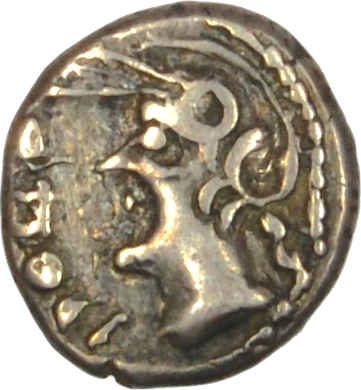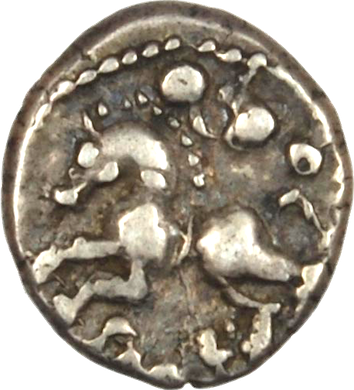 
Sequani, the 110-50 BC AR AR13 2 g 1.3 cm 1.3 cm
obverse: hd l helmeted (Roma /) Q DOCI
reverse: horse galloping l DOCI above, SAM F beneath
Sear GCV 95
Holleman munten lijst 87 (1991) 1
Before the arrival of Julius Caesar in Gaul, the Sequani had taken the side of the Arverni against their rivals
the Aedui and hired the Suebi under Ariovistus to cross the Rhine and help them (71 BC). Although his assistance
enabled them to defeat the Aedui, the Sequani were worse off than before, for Ariovistus deprived them of a third
of their territory and threatened to take another third, while subjugating them into semi-slavery.
The Sequani then appealed to Caesar, who drove back the Germanic tribesmen (58 BC), but at the same time obliged
the Sequani to surrender all that they had gained from the Aedui. This so exasperated the Sequani that they joined
in the revolt of Vercingetorix (52 BC) and shared in the defeat at Alesia.Under Augustus, the district known as
Sequania formed part of Belgica. After the death of Vittelius (69 CE), the inhabitants refused to join the Gallic
revolt against Rome instigated by Gaiuzs Juliuc Civilis and Julius Sabinus, and drove back Sabinus, who had invaded
their territory. A triumphal arch at Vesontio (Besancon), which in return for this service was made a colony,
possibly commemorates this victory.
Diocletian added Helvetia added, and part of Germania Superior to Sequania, which was now called Provincia Maxima
Sequanorum, Vesontio receiving the title of Metropolis civitas Vesontiensium. Fifty years later, Gaul was overrun
by the barbarians, and Vesontio sacked (355). Under Julian, it recovered some of its importance as a fortified town,
and was able to withstand the attacks of the Vandals. Later, when Rome was no longer able to afford protection to
the inhabitants of Gaul, the Sequani became merged in the newly formed Kingdom of Burgundy.
|